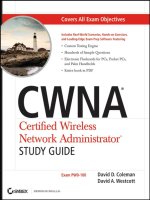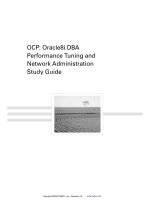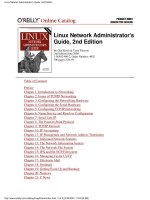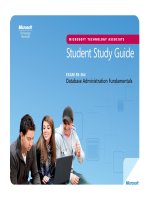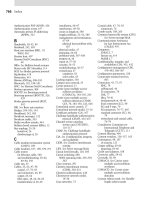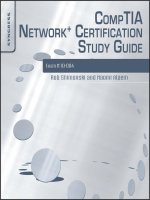cwna certified wireless network administrator study guide exam
Bạn đang xem bản rút gọn của tài liệu. Xem và tải ngay bản đầy đủ của tài liệu tại đây (14.34 MB, 594 trang )
CWNA
®
Certified Wireless
Network Administrator™
Study Guide
David D. Coleman
David A. Westcott
Wiley Publishing, Inc.
CWNA
®
Certified Wireless
Network Administrator™
Study Guide
CWNA
®
Certified Wireless
Network Administrator™
Study Guide
David D. Coleman
David A. Westcott
Wiley Publishing, Inc.
Acquisitions and Development Editor: Jeff Kellum
Technical Editor: Sam Coyl
Production Editor: Martine Dardignac
Copy Editor: Judy Flynn
Production Manager: Tim Tate
Vice President and Executive Group Publisher: Richard Swadley
Vice President and Executive Publisher: Joseph B. Wikert
Vice President and Publisher: Neil Edde
Permissions Editor: Shannon Walters
Media Development Specialist: Kate Jenkins
Book Designers: Judy Fung and Bill Gibson
Compositor: Laurie Stewart, Happenstance Type-O-Rama
Illustrator: Jeffrey Wilson, Happenstance Type-O-Rama
Proofreader: Nancy Riddiough
Indexer: Nancy Guenther
Cover Designer: Ryan Sneed
Copyright © 2006 by Wiley Publishing, Inc., Indianapolis, Indiana
Published simultaneously in Canada
ISBN-13: 978-0-471-78952-9
ISBN-10: 0-471-78952-6
No part of this publication may be reproduced, stored in a retrieval system or transmitted in any form or by any
means, electronic, mechanical, photocopying, recording, scanning or otherwise, except as permitted under Sections
107 or 108 of the 1976 United States Copyright Act, without either the prior written permission of the Publisher, or
authorization through payment of the appropriate per-copy fee to the Copyright Clearance Center, 222 Rosewood
Drive, Danvers, MA 01923, (978) 750-8400, fax (978) 646-8600. Requests to the Publisher for permission should
be addressed to the Legal Department, Wiley Publishing, Inc., 10475 Crosspoint Blvd., Indianapolis, IN 46256,
(317) 572-3447, fax (317) 572-4355, or online at />Limit of Liability/Disclaimer of Warranty: The publisher and the author make no representations or warranties with
respect to the accuracy or completeness of the contents of this work and specifically disclaim all warranties, including
without limitation warranties of fitness for a particular purpose. No warranty may be created or extended by sales
or promotional materials. The advice and strategies contained herein may not be suitable for every situation. This
work is sold with the understanding that the publisher is not engaged in rendering legal, accounting, or other professional services. If professional assistance is required, the services of a competent professional person should be
sought. Neither the publisher nor the author shall be liable for damages arising herefrom. The fact that an organization or Website is referred to in this work as a citation and/or a potential source of further information does not
mean that the author or the publisher endorses the information the organization or Website may provide or recommendations it may make. Further, readers should be aware that Internet Websites listed in this work may have
changed or disappeared between when this work was written and when it is read.
For general information on our other products and services or to obtain technical support, please contact our Customer
Care Department within the U.S. at (800) 762-2974, outside the U.S. at (317) 572-3993 or fax (317) 572-4002.
Wiley also publishes its books in a variety of electronic formats. Some content that appears in print may not be
available in electronic books.
Library of Congress Cataloging-in-Publication Data is available from the publisher.
TRADEMARKS: Wiley, the Wiley logo, and the Sybex logo are trademarks or registered trademarks of John
Wiley & Sons, Inc. and/or its affiliates, in the United States and other countries, and may not be used without written permission. CWNA and Certified Wireless Network Administrator are trademarks or registered trademarks
of Planet3 Wireless, Inc. in the United States and other countries. All other trademarks are the property of their
respective owners. Wiley Publishing, Inc., is not associated with any product or vendor mentioned in this book.
10 9 8 7 6 5 4 3 2 1
To Our Valued Readers:
Thank you for looking to Sybex for your CWNA exam prep needs. We at Sybex are proud
of our reputation for providing certification candidates with the practical knowledge and
skills needed to succeed in the highly competitive IT marketplace. Certification candidates
have come to rely on Sybex for accurate and accessible instruction on today’s crucial technologies and business skills.
Just as Planet3 is committed to establishing measurable standards for certifying IT wireless
administration professionals by means of the CWNA certification, Sybex is committed to
providing those individuals with the knowledge needed to meet those standards.
The authors and editors have worked hard to ensure that this edition of the CWNA: Certified Wireless Network Administrator Study Guide you hold in your hands is comprehensive,
in-depth, and pedagogically sound. We’re confident that this book will exceed the demanding standards of the certification marketplace and help you, the CWNA certification candidate, succeed in your endeavors.
As always, your feedback is important to us. If you believe you’ve identified an error in the
book, please send a detailed e-mail to And if you have general comments or suggestions, feel free to drop me a line directly at At Sybex
we’re continually striving to meet the needs of individuals preparing for certification exams.
Good luck in pursuit of your CWNA certification!
Neil Edde
Vice President & Publisher
Wiley Publishing, Inc.
We would like to dedicate this book to our parents, teachers, instructors, and
mentors, who have helped us throughout our lives. We hope that through this book
and through our teaching and mentoring we can help others achieve their goals.
Acknowledgments
David Coleman would like to thank his children, Brantley and Carolina, for their patience and
understanding of their father throughout the writing of the book. I love you kids very much.
David Westcott would like to thank his wife, Gina, for her patience, understanding, and
support and for the hours she spent reading and editing the book.
Writing the CWNA study guide has been a nine-month adventure that neither of us fully
grasped from the start. We would like to thank all of the following individuals for their support and contributions during the entire process.
We must first thank Acquisitions and Developmental Editor Jeff Kellum of Sybex Publishing for initially finding us and bringing us on to this project. Jeff is an extremely patient and
understanding editor who, despite our best efforts, needed to send us an occasional nasty e-mail
message. We would also like to thank Project Editor Martine Dardignac of Wiley. Martine
was an absolute pleasure to work with despite the fact that we drove her crazy. We would also
love to thank our copyeditor, Judy Flynn; our proofreader, Nancy Riddiough; the illustrators;
and our media development specialist, Shannon Walters.
We need to give a big shout out to our technical editor, Sam Coyle. Sam is a member of the
IEEE with many years of practical experience in wireless communications. His contributions to
the book were nothing short of invaluable. When Sam is not providing awesome technical editing, he is vice president of business development for Kandersteg\Netrepid (www.netrepid.com),
a wireless solutions provider.
We would also like to thank Devin Akin, Kevin Sandlin, Scott Turner, and Scott Williams
of the CWNP Program (www.cwnp.com). You gentlemen should be proud of the internationally renowned wireless certification program that you have developed. It has been a pleasure
working with all of you the past four years.
Thanks to Proxim and to Ken Ruppel () for allowing us to include
the video “Beam Patterns and Polarization of Directional Antennas” on the CD-ROM, and
thanks to Andrew Potter for making himself available for our photography needs.
Special thanks goes to Andras Szilagyi, not only for creating the EMANIM software program, but also for all the extra assistance he provided by working with us to create a customized version of the program for the CD-ROM.
We would also like to think the following individuals and companies for their contributions
to the book:
• Air Defense—Nico Darrow, Ralf Deltrap, and Bryan Harkins (www.airdefense.net)
• Air Magnet—Jonathan Bass and Chia Chee Kuan (www.airmagnet.com)
• AirWave (www.airwave.com)
• Andrew Potter Photography—Andrew Potter (www.andrewpotterphotography.com)
• Aruba Networks—Christopher Leach (www.arubanetworks.com)
• Cognio—William Flanagan and Margo Schlossberg (www.cognio.com)
• Cushcraft—Mark Miller (www.cushcraft.com)
• D-Link—(www.dlink.com)
• Ekahau—Jussi Kiviniemi (www.ekahau.com)
• Fortress Technologies—Andrea Shirley and Joe Tomasone (www.fortresstech.com)
viii
Acknowledgments
• Helium Networks—Keith Borden, Ed Finn, and Walt Halasowski
(www.heliumnetworks.com)
• Juniper Networks—Curt Hooper, Paul Levesque, and Matt Sweet (www.juniper.net)
• NetStumbler—Marius Milner (www.netstumbler.com)
• Ortronics—Jeff Davis, Arlene Franchini, and Irene Bammer (www.ortronics.com)
• Proxim—Ken Day, Pamela Valentine, and Amit Malhotra (www.proxim.com)
• SpectraLink—Melissa Aguirre, Ray Baum, Wayne McAllister, Wylee Post, and
Robin Raulf-Sager (www.spectralink.com)
• Spectrotech—Mark Morgan (www.spectrotech.com.au)
• TamoSoft—Michael Berg (www.tamosoft.com)
• Times Microwave Systems—Joe Lanoue (www.timesmicrowave.com)
• Wi-Fi Alliance—Kelly Davis-Felner (www.wifi.org)
• Wildpackets—Stephanie Temple (www.wildpackets.com)
Foreword
Wireless LANs seem to be everywhere these days. The technology is advancing so rapidly that
it seems almost impossible to stay abreast of all of the changes. The small office/home office
(SOHO) sector is adopting new WLAN technologies well before there are ratified amendments or interoperability certifications in place for each technology. The small/medium business (SMB) sector is slightly more cautious but often serves as a test bed for many leading-edge
technologies. The enterprise has adopted 802.11 technology slowly over the last five years,
and adoption has often been due to driving factors such as saving money, as with VoWiFi and
device tracking technologies, or being able to accomplish new business goals that could not be
achieved without wireless technology.
Wireless has recently become wildly popular in the enterprise, and vendors are frantically
releasing new products into the market. With a relentless stream of new technologies and
products comes an increased demand for education and certification. The CWNP Program is
dedicated strictly to staying abreast of all facets of 802.11 technology—with both standards
and products. The CWNA certification is the first step in the CWNP line of certifications and
is focused on administering an enterprise 802.11 WLAN. CWNA includes topics such as
802.11 standards, security, management, protocol analysis, QoS, site surveying, and radio frequency. Additional certifications focus more intensely on security, protocol analysis, QoS, and
RF spectrum management.
David Coleman and David Westcott have worked as Certified Wireless Network Trainers
(CWNTs) for as long as the CWNT certification has been available, and each was quick to
pursue all CWNP certifications as they were released. Each has years of experience with a
breadth of WLAN technologies and leading-edge products, which is obvious to their students and anyone working alongside them in the field. Having worked with each of these
gentlemen for years, I can confidently say there could be no finer pair of seasoned trainers
collaborating on a CWNA book. These WLAN veterans have devoted hundreds of hours to
pouring their experience into this book, and the reader is assured to acquire a plethora of
802.11 knowledge. Mr. Coleman and Mr. Westcott have participated in the shaping of the
CWNP Program as a whole since its earliest days and have each added tremendous value to
the CWNA certification specifically. I would like to thank each of these fine gentlemen for
their unwavering support of the CWNP Program, and I would like to congratulate them
on their diverse accomplishments as engineers, trainers, and now authors.
Devin Akin
Chief Technology Officer
The CWNP Program
Contents at a Glance
Introduction
xxiii
Assessment Test
xxxviii
Chapter 1
Overview of Wireless Standards and Organizations
1
Chapter 2
Radio Frequency Fundamentals
23
Chapter 3
Radio Frequency Components, Measurements,
and Mathematics
55
Chapter 4
Radio Frequency Signal and Antenna Concepts
91
Chapter 5
IEEE 802.11 Standards
133
Chapter 6
Wireless Networks and Spread Spectrum Technologies
163
Chapter 7
Wireless LAN Topologies
193
Chapter 8
802.11 Medium Access
219
Chapter 9
802.11 MAC Architecture
251
Chapter 10
Wireless Devices
275
Chapter 11
Network Design, Implementation, and Management
309
Chapter 12
WLAN Troubleshooting
327
Chapter 13
802.11 Network Security Architecture
357
Chapter 14
Wireless Attacks, Intrusion Monitoring, and Policy
387
Chapter 15
Radio Frequency Site Survey Fundamentals
417
Chapter 16
Site Survey Systems and Devices
443
Glossary
477
Index
509
Contents
Introduction
xxiii
Assessment Test
Chapter
2
Overview of Wireless Standards and Organizations
1
Identifying Standards Organizations
Federal Communications Commission (FCC)
International Telecommunication Union
Radiocommunication Sector (ITU-R)
Institute of Electrical and Electronics Engineers (IEEE)
Wi-Fi Alliance
International Organization for Standardization
Communications Fundamentals
Understanding Carrier Signals
Understanding Keying Methods
Summary
Exam Essentials
Key Terms
Review Questions
Answers to Review Questions
Chapter
1
xxxviii
2
3
4
5
6
7
8
8
11
14
15
15
16
20
Radio Frequency Fundamentals
23
What Is an RF (Radio Frequency) Signal?
Identifying Radio Frequency Characteristics
Polarity
Wavelength
Frequency
Amplitude
Phase
Identifying RF Behaviors
Wave Propagation
Absorption
Reflection
Scattering
Refraction
Diffraction
Loss (Attenuation)
Free Space Path Loss
Multipath
Gain (Amplification)
Summary
25
25
26
27
29
30
31
32
32
33
35
36
37
38
39
41
42
46
47
xii
Contents
Exam Essentials
Key Terms
Review Questions
Answers to Review Questions
Chapter
3
4
Radio Frequency Components, Measurements,
and Mathematics
55
RF Components
Transmitter
Antenna
Receiver
Intentional Radiator (IR)
Equivalent Isotropically Radiated Power (EIRP)
Units of Power and Comparison
Watt
Milliwatt (mW)
Decibel (dB)
dBi
dBd
dBm
RF Mathematics
Rule of 10s and 3s
Received Signal Strength Indicator (RSSI)
System Operating Margin (SOM)/Link Budget
Fade Margin
Inverse Square Law
Summary
Exam Essentials
Key Terms
Review Questions
Answers to Review Questions
Chapter
47
48
49
53
57
57
58
59
59
59
60
61
61
61
63
65
65
66
67
76
77
80
81
81
83
83
84
88
Radio Frequency Signal and Antenna Concepts
91
Active and Passive Gain
Azimuth and Elevation Chart
Beamwidth
Antenna Types
Omni-directional Antennas
Semi-directional Antennas
Highly-directional Antennas
Phased Array
Sector Antennas
93
94
96
97
98
100
103
104
104
Contents
Visual Line of Sight
RF Line of Sight
Fresnel Zone
Earth Bulge
Antenna Polarization
Antenna Diversity
Multiple Input Multiple Output (MIMO)
Antenna Connection and Installation
Voltage Standing Wave Ratio (VSWR)
Antenna Mounting
Antenna Accessories
Cables
Connectors
Splitters
Amplifiers
Attenuators
Lightning Arrestors
Grounding Rods and Wires
Summary
Exam Essentials
Key Terms
Review Questions
Answers to Review Questions
Chapter
5
IEEE 802.11 Standards
Overview of the IEEE 802.11 Standard
IEEE 802.11 Ratified Amendments
802.11b Amendment
802.11a Amendment
802.11g
802.11d
802.11F
802.11h
802.11i
802.11j
802.11e
IEEE 802.11 Draft Amendments
802.11k
802.11m
802.11n
802.11p
802.11r
802.11s
xiii
105
105
106
109
111
111
113
113
113
115
118
118
119
120
120
121
121
123
125
125
126
127
131
133
135
136
136
137
139
141
142
144
145
146
147
148
148
149
149
150
150
151
xiv
Contents
802.11T
802.11u
802.11v
802.11w
Summary
Exam Essentials
Key Terms
Review Questions
Answers to Review Questions
Chapter
6
Wireless Networks and Spread Spectrum
Technologies
Industrial, Scientific, and Medical (ISM) Bands
900 MHz ISM Band
2.4 GHz ISM Band
5.8 GHz ISM Band
Unlicensed National Information Infrastructure Bands (UNII)
Lower Band (UNII-1)
Middle Band (UNII-2)
Upper Band (UNII-3)
Narrowband and Spread Spectrum
Frequency Hopping Spread Spectrum (FHSS)
Hopping Sequence
Dwell Time
Hop Time
Modulation
802.11/b/g Channels
Direct Sequence Spread Spectrum (DSSS)
DSSS Data Encoding
Modulation
Packet Binary Convolutional Code (PBCC)
Orthogonal Frequency Division Multiplexing (OFDM)
Convolution Coding
802.11a Channels
Throughput vs. Bandwidth
Communication Resilience
Summary
Exam Essentials
Key Terms
Review Questions
Answers to Review Questions
151
152
153
153
154
154
155
157
161
163
165
165
166
166
166
167
167
167
168
170
170
171
171
172
172
176
176
177
178
178
180
181
182
183
183
184
185
186
190
Contents
Chapter
7
Wireless LAN Topologies
Wireless Networking Topologies
Wireless Wide Area Network (WWAN)
Wireless Metropolitan Area Network (WMAN)
Wireless Personal Area Network (WPAN)
Wireless Local Area Network (WLAN)
802.11 Topologies
Access Point
Client Stations
Distribution System (DS)
Wireless Distribution System (WDS)
Service Set Identifier (SSID)
Basic Service Set (BSS)
Basic Service Set Identifier (BSSID)
Basic Service Area (BSA)
Extended Service Set (ESS)
Independent Basic Service Set (IBSS)
Nonstandard 802.11 Topologies
802.11 Configuration Modes
Access Point Modes
Client Station Modes
Summary
Exam Essentials
Key Terms
Review Questions
Answers to Review Questions
Chapter
8
802.11 Medium Access
CSMA/CA vs. CSMA/CD
Distributed Coordination Function (DCF)
Interframe Space (IFS)
Collision Detection
Duration/ID Field
Carrier Sense
Random Backoff Time
Distributed Coordination Function (DCF) Flowchart
Point Coordination Function (PCF)
802.11 Frame Format vs. 802.3 Frame Format
Three Frame Types
Management Frames
Control Frames
Data Frames
xv
193
194
195
195
196
197
197
198
199
199
200
201
202
203
203
204
206
207
208
208
209
209
210
211
212
216
219
221
222
223
223
224
224
225
226
228
229
229
230
230
231
xvi
Contents
Layer 3 Integration with 802.11 Frames
Beacon Management Frame (Beacon)
Passive Scanning
Active Scanning
Authentication
Open System Authentication
Shared Key Authentication
Association
Authentication and Association States
Roaming
Reassociation
Disassociation
Deauthentication
Summary
Exam Essentials
Key Terms
Review Questions
Answers to Review Questions
Chapter
9
802.11 MAC Architecture
ACK Frame
Fragmentation
802.11g Protection Mechanism
RTS/CTS
CTS-to-Self
Power Management
Active Mode
Power Save Mode
Traffic Indication Map (TIM)
Delivery Traffic Indication Message (DTIM)
Announcement Traffic Indication Message (ATIM)
Wireless Multimedia (WMM)
Summary
Exam Essentials
Key Terms
Review Questions
Answers to Review Questions
Chapter
10
Wireless Devices
Wireless LAN Client Devices
Radio Card Formats
Radio Card Chipsets
Client Utilities
231
232
232
233
234
235
236
237
238
240
240
241
241
242
242
243
244
248
251
252
253
255
257
260
260
261
261
261
262
263
263
265
266
267
268
272
275
276
276
280
281
Contents
Progression of WLAN Architecture
Access Point–Intelligent Edge Architecture
Wireless Network Management System (WNMS)
Centralized WLAN Architecture
Distributed WLAN Architecture
Unified WLAN Architecture
Specialty WLAN Infrastructure Devices
Wireless Workgroup Bridge
Wireless LAN Bridges
Enterprise Wireless Gateway
Residential Wireless Gateway
VPN Wireless Router
Wireless LAN Mesh Routers
Enterprise Encryption Gateway
Virtual AP System
Power over Ethernet (PoE)
PoE Devices
Endspan
Midspan
Summary
Exam Essentials
Key Terms
Review Questions
Answers to Review Questions
Chapter
11
xvii
283
284
285
286
288
289
289
289
290
292
294
295
295
295
297
297
297
298
298
298
299
300
301
306
Network Design, Implementation, and
Management
309
Core, Distribution, and Access
Capacity vs. Coverage
Corporate Data Access and End User Mobility
Network Extension to Remote Areas
Bridging—Building-to-Building Connectivity
Wireless ISP (WISP)
Small Office, Home Office (SOHO)
Mobile Office Networking
Educational/Classroom Use
Industrial—Warehousing and Manufacturing
Healthcare—Hospitals and Offices
Public Network Access
Summary
Exam Essentials
Key Terms
Review Questions
Answers to Review Questions
310
311
313
313
314
314
315
315
316
316
317
317
318
319
319
320
324
xviii
Contents
Chapter
12
WLAN Troubleshooting
802.11 Coverage Considerations
Dynamic Rate Switching
Roaming
Layer 3 Roaming
Co-Channel Interference
Channel Reuse
Hidden Node
Near/Far
Interference
Performance
Weather
Summary
Exam Essentials
Key Terms
Review Questions
Answers to Review Questions
Chapter
13
802.11 Network Security Architecture
802.11 Security Basics
Encryption
AAA
Segmentation
Legacy 802.11 Security
Legacy Authentication
Static WEP Encryption
MAC Filters
SSID Cloaking
Authentication and Authorization
802.1X/EAP Framework
EAP Types
Dynamic Encryption Key Generation
WPA/802.11i
Robust Security Network (RSN)
4-Way Handshake
WPA/WPA2 Personal
TKIP
CCMP
Segmentation
VLANs
RBAC
Infrastructure Security
Physical Security
Interface Security
327
328
329
331
333
334
336
338
343
343
345
346
347
347
348
349
353
357
359
360
360
361
361
361
362
365
365
366
366
368
369
370
371
372
372
373
373
374
374
374
375
375
376
Contents
VPN Wireless Security
Layer 3 VPNs
Summary
Exam Essentials
Key Terms
Review Questions
Answers to Review Questions
Chapter
14
15
376
376
378
378
379
380
384
Wireless Attacks, Intrusion Monitoring, and Policy 387
Wireless Attacks
Rogue Access Point
Peer-to-Peer Attacks
Eavesdropping
Encryption Cracking
Authentication Attacks
MAC Spoofing
Management Interface Exploits
Wireless Hijacking
Denial of Service (DoS)
Intrusion Monitoring
Wireless Intrusion Detection System (WIDS)
Wireless Intrusion Prevention System (WIPS)
Mobile WIDS
Spectrum Analyzer
Wireless Security Policy
General Security Policy
Functional Security Policy
Legislative Compliance
802.11 Wireless Policy Recommendations
Summary
Exam Essentials
Key Terms
Review Questions
Answers to Review Questions
Chapter
xix
Radio Frequency Site Survey Fundamentals
WLAN Site Survey Interview
Customer Briefing
Business Requirements
Capacity and Coverage Requirements
Existing Wireless Network
Infrastructure Connectivity
Security Expectations
388
389
390
390
393
393
394
395
395
396
398
398
401
402
403
404
404
405
405
406
407
408
408
409
413
417
418
418
419
420
422
423
425
xx
Contents
Documents and Reports
Forms and Customer Documentation
Deliverables
Additional Reports
Vertical Market Considerations
Outdoor Surveys
Aesthetics
Government
Education
Healthcare
Hotspots
Retail
Warehouses
Manufacturing
Multitenant Buildings
Summary
Exam Essentials
Key Terms
Review Questions
Answers to Review Questions
Chapter
16
426
426
428
429
430
430
431
431
431
432
432
432
433
433
434
434
434
435
436
441
Site Survey Systems and Devices
443
Site Survey Defined
Mandatory Spectrum Analysis
Mandatory Coverage Analysis
AP Placement and Configuration
Optional Application Analysis
Site Survey Tools
Indoor Site Surveys Tools
Outdoor Site Survey Tools
Coverage Analysis
Manual
Assisted
Predictive
Self-Organizing Wireless LANs
Summary
Exam Essentials
Key Terms
Review Questions
Answers to Review Questions
Glossary
Index
444
445
449
453
454
455
456
457
460
460
464
465
466
467
467
468
469
474
477
509
Table of Exercises
Exercise
2.1
Visual Demonstration of Absorption
. . . . . . . . . . . . . . . 40
Exercise
2.2
Visual Demonstration of Multipath and Phase
Exercise
3.1
Step-by-Step Procedure . . . . . . . . . . . . . . . . . . . . . 67
Exercise
3.2
Rule of 10s and 3s Example 1 . . . . . . . . . . . . . . . . . . 69
Exercise
3.3
Rule of 10s and 3s Example 2 . . . . . . . . . . . . . . . . . . 70
Exercise
3.4
Rule of 10s and 3s Example 3 . . . . . . . . . . . . . . . . . . 73
Exercise
3.5
Rule of 10s and 3s Example 4 . . . . . . . . . . . . . . . . . . 75
Exercise
8.1
Frame Analysis . . . . . . . . . . . . . . . . . . . . . . . 239
Exercise
16.1
Spectrum Analysis . . . . . . . . . . . . . . . . . . . . . . 446
Exercise
16.2
Link Budget and Fade Margin . . . . . . . . . . . . . . . . . 459
Exercise
16.3
Cable Loss Calculations . . . . . . . . . . . . . . . . . . . . 459
Exercise
16.4
Manual Coverage Analysis
Exercise
16.5
Predictive Coverage Analysis
. . . . . . . . . . . 44
. . . . . . . . . . . . . . . . . . 463
. . . . . . . . . . . . . . . . . 466
